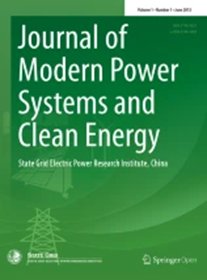A Continuous Operating Envelope for Managing Intra-Interval Fluctuations: Modeling and Solution
IF 6.1
1区 工程技术
Q1 ENGINEERING, ELECTRICAL & ELECTRONIC
Journal of Modern Power Systems and Clean Energy
Pub Date : 2024-11-27
DOI:10.35833/MPCE.2024.000636
引用次数: 0
Abstract
Maintaining a continuous power balance is crucial for ensuring operational feasibility in power systems. However, due to forecasting difficulties and computational limitations, economic dispatch often relies on discrete interval horizons, which fail to guarantee feasibility within each interval. This paper introduces the concept of a continuous operating envelope for managing intra-interval fluctuations, delineating the range within which fluctuations remain manageable. We propose a parametric programming model to construct the envelope, represented as a polytope that accounts for both timescale and fluctuation dimensions. To address the computational challenges inherent in the parametric programming model, we develop a fast solution method to provide an approximated polytope. The approximated polytope, initially derived from lower-dimensional projections, represents a subset of the exact polytope that ensures operational feasibility. Additionally, we apply a polytope expansion strategy in the original dimensions to refine the approximated polytope, bringing the approximation closer to the exact polytope. Case studies on an illustrative 5-bus and a utility-scale 661-bus system demonstrate that the method effectively and stably provides a continuous operating envelope, particularly for high-dimensional problems.管理区间内波动的连续操作包络:建模与求解
维持持续的功率平衡是确保电力系统运行可行性的关键。然而,由于预测困难和计算限制,经济调度往往依赖于离散的区间范围,无法保证在每个区间内的可行性。本文引入了管理区间内波动的连续操作包络的概念,描述了波动保持可管理的范围。我们提出了一个参数规划模型来构建包络,表示为一个多面体,同时考虑了时间尺度和波动维度。为了解决参数规划模型固有的计算挑战,我们开发了一种快速求解方法来提供近似多面体。近似多面体,最初来源于低维投影,代表了确保操作可行性的精确多面体的子集。此外,我们在原始维度上应用多面体展开策略对逼近多面体进行细化,使逼近多面体更接近精确多面体。对一个5总线和一个公用事业规模的661总线系统的实例研究表明,该方法有效和稳定地提供了一个连续的运行包络,特别是对于高维问题。
本文章由计算机程序翻译,如有差异,请以英文原文为准。
求助全文
约1分钟内获得全文
求助全文
来源期刊

Journal of Modern Power Systems and Clean Energy
ENGINEERING, ELECTRICAL & ELECTRONIC-
CiteScore
12.30
自引率
14.30%
发文量
97
审稿时长
13 weeks
期刊介绍:
Journal of Modern Power Systems and Clean Energy (MPCE), commencing from June, 2013, is a newly established, peer-reviewed and quarterly published journal in English. It is the first international power engineering journal originated in mainland China. MPCE publishes original papers, short letters and review articles in the field of modern power systems with focus on smart grid technology and renewable energy integration, etc.
 求助内容:
求助内容: 应助结果提醒方式:
应助结果提醒方式:


